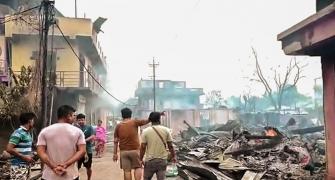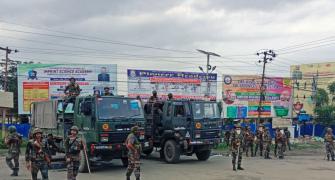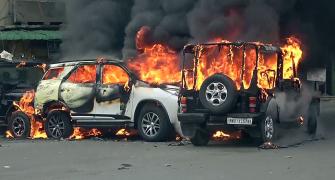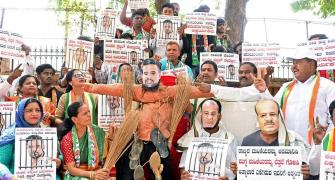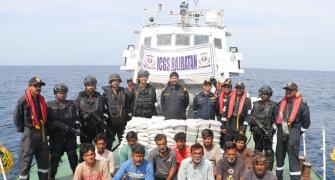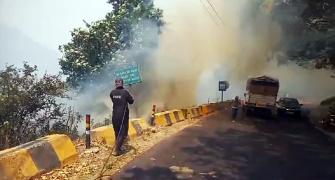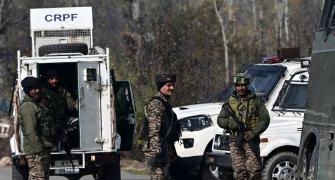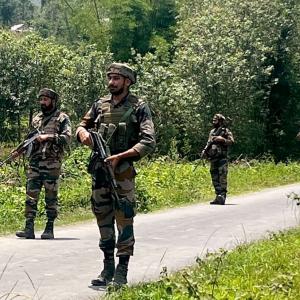'Meiteis started feeling insecure stating that the illegal immigrant population is growing in the valley, and that the majority community would become a minority.'

It will be two months on Monday since violence erupted in Manipur on May 3, 2023. The North East state continues to be in turmoil with no respite to the violence in sight.
"To a great extent, the demographical factor is also responsible for the violence. Around 60% of the total population of the state live in the valley and 40% in the hills. But geographically, the valley covers only 10% of the total area of the state while the hill areas cover 90%!", Professor Lal Dena, former head of the History department, Manipur University and former vice-chancellor, Sangai University, Manipur, points out to Rediff.com's Shobha Warrier.
The first of a two-part interview:
If you look back at the history of Manipur, were those who lived in the valley different from the tribals from the hills?
Were there skirmishes between the two, or did they live harmoniously?
Racially, there is no difference between the Meiteis who live in the valley and the Kuki-Zomi-Mizo (KZM) who live in the hills.
All the inhabitants of Manipur belong to the Mongoloid race of South Asia origin.
The process of state formation took place in the valley where the Meiteis lived, way back in the 15th century because of their advanced civilisation which is of course, specific to fertile valleys.
This was followed by the rule of the maharajas.
On the other hand, those who lived in the hills were administered by the institution of chieftainship which was based on their own customary laws.
So, the people in the valley and those in the hills had a different polity, social and economic set up in the past.
As far as skirmishes between the two, only in the recent past, there occurred some minor issues between the two, but there was no major incident like we see today.
Can you pinpoint any particular incident in the history of the region that resulted in mistrust between those who lived in the valley and those in the hills?
It all started during the reign of Garibaniwaza, between 1709-1748 when the Meiteis adopted Vaishnavite Hinduism which came from Bengal.
With this, orthodoxy and conservatism came into existence in Meitei society which include caste structures too.
This was happening for the first time in the history of Manipur.
As a result, the Meiteis began to adopt a holier-than-thou attitude and they started looking down upon the hill people.
For instance, even money from a tribal person used to be considered unclean and he was asked to place it on the ground or somewhere far away.
When the Christian missionaries came to the region, the colonial officials did not let them work among the Hindu Meiteis.
They were advised to go to the hills, and that was how the Kuki Zo descendants were converted into Christianity. This happened in the early 20th century.
With this, the social divide between the two communities widened.
Another incident which caused mistrust between the two communities was the controversial 2015 Three Bills -- The protection of Manipur people, Manipur Land revenue and land reforms and the Manipur shops and establishments bill, 2015.
This was passed by the Congress ministry under Ibobi Singh.
There were protests by the tribals against the bills which resulted in the death of nine people, and many were injured.
The bills were ultimately withdrawn, and peace was eventually restored.

Do you attribute the current violence to the high court order asking the state government to look into the issue of granting Scheduled Tribe status to the Meiteis?
Yes. The high court order may be taken as an immediate cause of the current violence.
On the 3rd May 2023, the All-Tribal Students' Union, Manipur organised a peace mass rally in all the hill districts of Manipur in protest against the court order.
However, some miscreants burnt the Anglo-Kuki centenary war structure at Leisang, which is about two kms from Lamka town.
This was followed by more burning and shooting in the boundary between the hill district and the valley, and large scale destruction and killings in Imphal, Churachandpur and other places.
Another cause for the present violence is the proposed enforcement of the Forest Conservation (Amendment) Bill in the Kuki inhabited districts, and eviction of selected villages and churches in the name of the encroachment of government land.
This resulted in the emergence of groups such as Arambai Tenggol and Meitei Leepun who mobilised large numbers of black uniformed youth.

Has the imbalance in the population occupying the valley, the Meiteis and the Kukis in the hills contributed to the tension?
Yes. To a great extent, the demographical factor is also responsible for the violence.
Around 60% of the total population of the state live in the valley and 40% in the hills.
But geographically, the valley covers only 10% of the total area of the state while the hill areas cover 90%!
Like many other Indian cities, Imphal is growing in terms of infrastructure, market and population.
Tribals -- especially the government employees and students -- have also started settling permanently in the valley like in Hoakip Veng, Paite Veng, etc.
Soon Meiteis started feeling insecure stating that the illegal immigrant population is growing in the valley, and that the majority community would become a minority.
On the other hand, the tribal community felt that all the government institutions and other infrastructure development is concentrated only in the capital.
This is another reason for the tension.
 IMAGE: Professor Lal Dena
IMAGE: Professor Lal DenaIs that why the Meiteis are asking for Scheduled Tribe status?
The Meitei Scheduled Tribe Demand Committee in a television interview said that they were demanding scheduled tribe status not for reservation or any quota, but to have the right to forest land.
So the basic issue is land.
It is said that the influx of refugees from Myanmar and the government not granting them the status of refugees is another reason for the present violence. Do you agree?
Influx of refugees from Myanmar is not the cause of the present conflict. In fact, they are not involved in the conflict at all.
Approximately 8,000 refugees from Myanmar entered the state from the time military rule was imposed in Myanmar.
However, based on a report from the humanitarian aid workers on the ground, 90% of them left for Mizoram after violence broke out in Manipur.
Feature Presentation: Aslam Hunani/Rediff.com

